WD’s Red 4TB HDD expands on the company’s current offering with 33% more raw storage capacity than previously available in the same 3.5″ form factor with a 6Gb/s SATA interface. The WD Red line also features 1TB, 2TB, and 3TB models, but now consumers and small businesses with one- to five-bay NAS units can install or upgrade to the full 4TB maximum, the most robust storage capacity in the industry. Other standard features with the Red 4TB are a 64MB cache and WD’s Intellipower low power spindle. This Intellipower technology is significant as drives in this segment experience continuous 24×7 operation and are required to consume minimal amounts of energy in order to reduce costs.
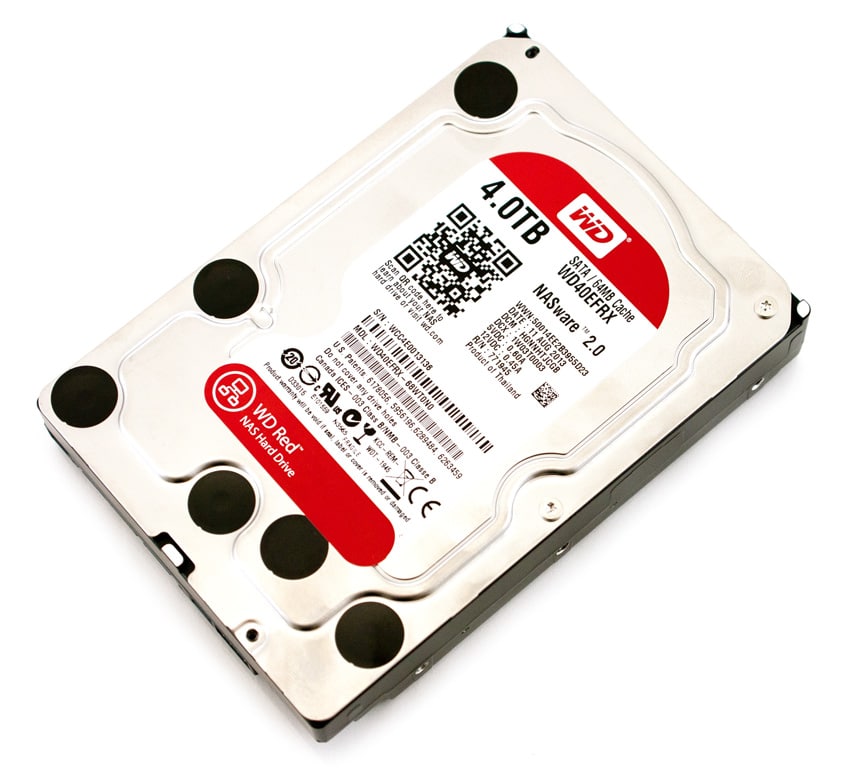
NAS hard drives aren’t necessarily required to be the highest performing drives on the market. For most buyers, the primary considerations are reliability and warranty as well as the capacity points offered. This market also places more importance on how the drive is going to operate over its lifespan. That’s not to say performance isn’t a possible deliberation, and the WD Red features a quoted transfer rate around 150MB/s.
The WD Red ships with features to enhance the performance and reliability of the drive. 3D Active Balance Plus is a dual-plane balance control technology that enhances overall drive performance and reliability by reducing vibration and its associated wear and tear on internal components. WD uses NASware firmware on all Red HDDs, with version 2.0 standard on the 4TB model. This firmware reduces noise and power consumption, enables users to monitor performance and reliability via the SMART command set, and provides error recovery tools.
WD Red 4TB HDD Specifications
- Model number: WD40EFRX
- Interface: SATA 6 Gb/s
- Formatted capacity: 4TB
- Form factor: 3.5-inch
- Advanced Format (AF): Yes
- RoHS compliant: Yes
- Data transfer rate (max)
- Interface speed: 6 Gb/s
- Internal transfer rate: 150 MB/s
- Cache (MB): 64
- Rotational speed (RPM): IntelliPower
- Load/unload cycles: 300,000
- Non-recoverable read errors per bits read: <1 in 1014
- MTBF (hours): 1,000,000
- Limited warranty (years): 3
- 12VDC ±10% (A, peak): 1.75
- 5VDC ±10% (A, peak): –
- Average power requirements (W)
- Read/Write: 4.5
- Idle: 3.3
- Standby/Sleep: 0.4
- Temperature (°C)
- Operating: 0 to 70
- Non-operating: -40 to 70
- Shock (Gs)
- Operating (2 ms, read/write): 30
- Operating (2 ms, read): 65
- Non-operating (2 ms): 250
- Acoustics (dBA)
- Idle: 25
- Seek (average): 28
- Height (in./mm): 1.028/26.1
- Length (in./mm): 5.787/147
- Width (in./mm, ± .01 in.): 4/101.6
- Weight (lb./kg, ± 10%): 1.50/0.68
Design and Build
The WD Red 4TB features a design similar to the WD Red 3TB we reviewed. The top of the drive features the WD branding on a product information label. While the 3TB model features four black stickers covering screws on the top cover, this 4TB model includes six.
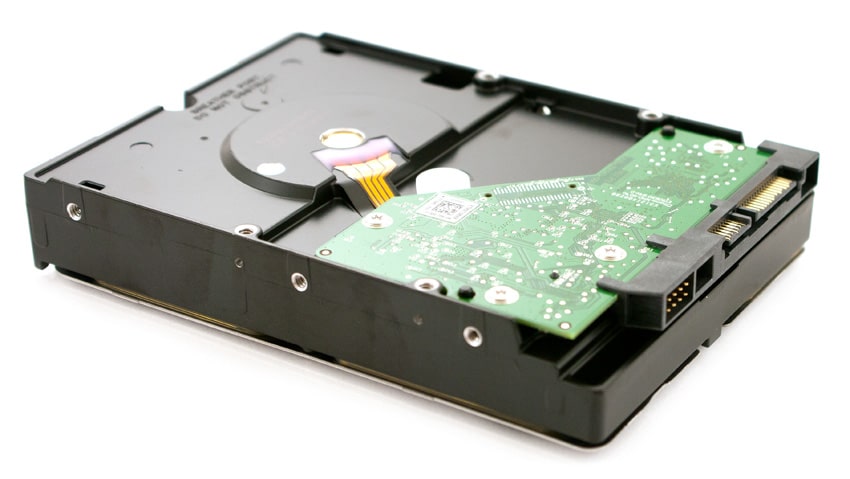
Standard for WD HDDs, the body of the WD Red 4TB HDD is black metal. On the back of the drive, there are standard power and SATA connectors. Moving to the bottom, to remove the circuit board, we needed to remove four screws. The circuit board incorporates thermal pads to passively cool the internal components.
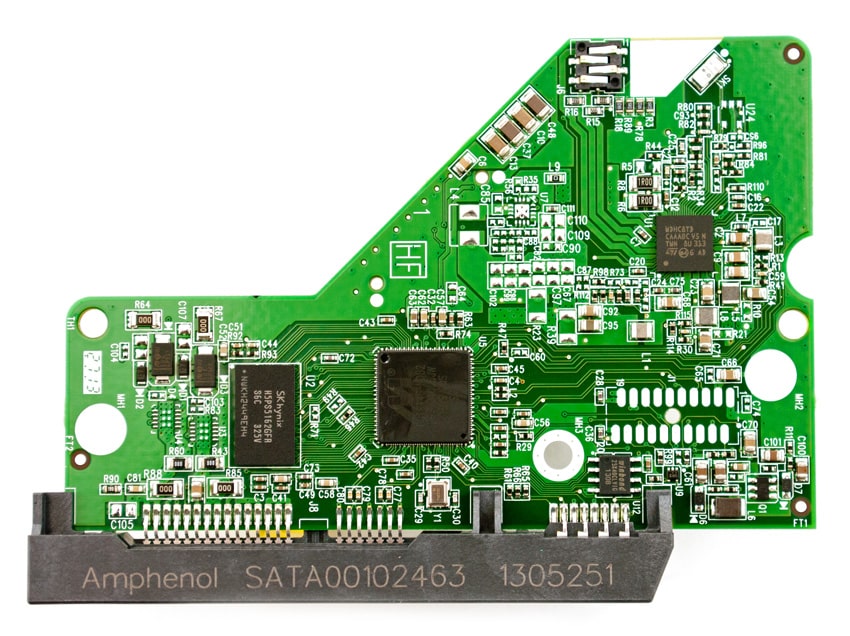
The WD Red 4TB HDD utilizes the Marvell 88i9446-NDB2 controller as well as 64MB of DRAM cache from the SKhynix H5PS5162GFA.
Testing Background and Comparables
HDD comparables for this review:
- Seagate Constellation CS – Enterprise Value HDD (3TB, 7,200 RPM)
- Seagate NAS HDD (4TB, 5,900 RPM)
- WD Se (4TB, 7,200RPM)
- WD Red NAS (3TB, 5K-Class RPM)
All enterprise HDDs are benchmarked on our enterprise testing platform based on a Lenovo ThinkServer RD240. The ThinkServer RD240 is configured with:
- 2 x Intel Xeon X5650 (2.66GHz, 12MB Cache)
- Windows Server 2008 Standard Edition R2 SP1 64-Bit and CentOS 6.2 64-Bit
- Intel 5500+ ICH10R Chipset
- Memory – 8GB (2 x 4GB) 1333Mhz DDR3 Registered RDIMMs
- LSI 9211 SAS/SATA 6.0Gb/s HBA
Enterprise Synthetic Workload Analysis
Our synthetic enterprise storage benchmark process begins with an analysis of the way the drive performs during a thorough preconditioning phase. Each of the comparable drives are secure erased using the vendor’s tools, preconditioned into steady state with the same workload the device will be tested with under a heavy load of 16 threads with an outstanding queue of 16 per thread, and then tested in set intervals in multiple thread/queue depth profiles to show performance under light and heavy usage.
Preconditioning and Primary Steady State Tests:
- Throughput (Read+Write IOPS Aggregate)
- Average Latency (Read+Write Latency Averaged Together)
- Max Latency (Peak Read or Write Latency)
- Latency Standard Deviation (Read+Write Standard Deviation Averaged Together)
Our Enterprise Synthetic Workload Analysis includes two profiles based on real-world tasks. These profiles have been developed to make it easier to compare to our past benchmarks as well as widely-published values such as max 4k read and write speed and 8k 70/30, which is commonly used for enterprise drives.
- 4k
- 100% Read or 100% Write
- 100% 4k
- 8k 70/30
- 70% Read, 30% Write
- 100% 8k
- 128k (Sequential)
- 100% Read or 100% Write
- 100% 128k
- File Server
- 80% Read, 20% Write
- 10% 512b, 5% 1k, 5% 2k, 60% 4k, 2% 8k, 4% 16k, 4% 32k, 10% 64k
- Webserver
- 100% Read
- 22% 512b, 15% 1k, 8% 2k, 23% 4k, 15% 8k, 2% 16k, 6% 32k, 7% 64k, 1% 128k, 1% 512k
In the first workload, we measured a long sample of random 4k performance with 100% write and 100% read activity. The WD Red 4TB scored 107 IOPS read and 137 IOPS write, placing it in the middle of the distribution of results, and notably better than the Red 3TB.
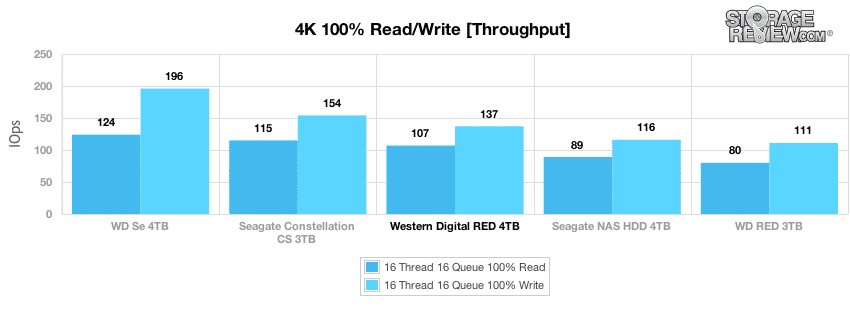
In our average latency segment with a load of 16T/16Q, the WD Red 4TB again scored in the middle of the comparables.
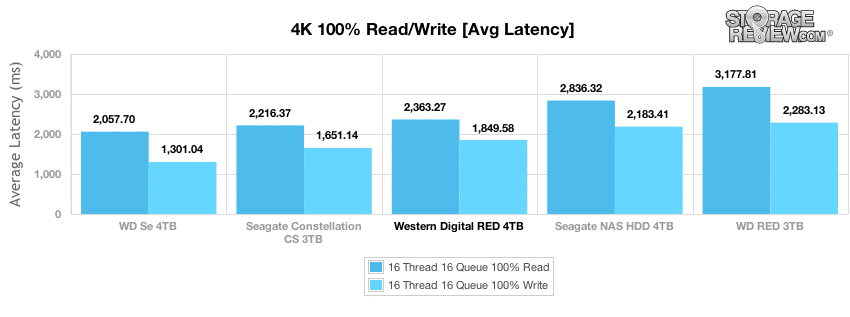
The 4K maximum latency benchmark is the first place the Red 4TB distinguishes itself: a 4,799ms maximum read latency is the lowest among comparables. Its 5,012ms maximum write latency represents the middle of the road.
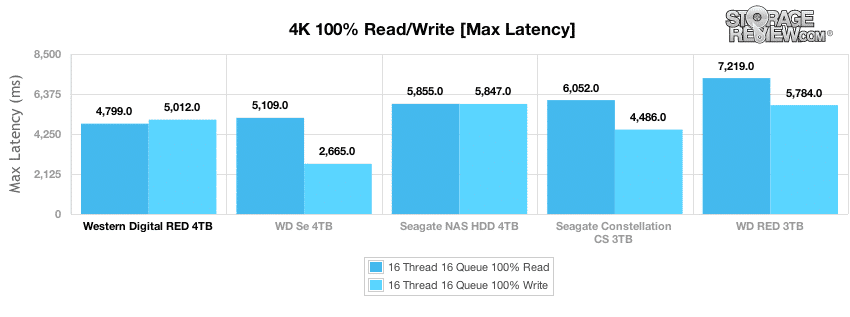
Charting standard deviation further illustrates that the WD Red 4TB is competitive among large HDDs designed for NAS applications.
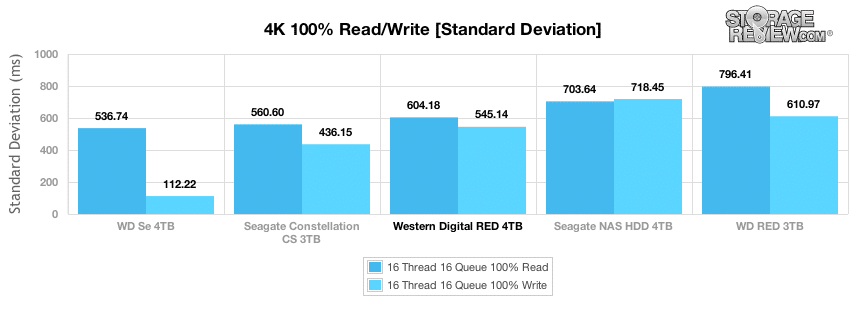
Mixed workload profiles scale performance across a range of thread and queue depth combinations. In the following benchmarks, we scale the workload from 2 threads and 2 queue depth up to 16 threads and 16 queue. In the 8k 70/30 test, the WD Red 4TB generally performed near the middle of its comparables, aside from strong performance with two threads and relatively deep queues.
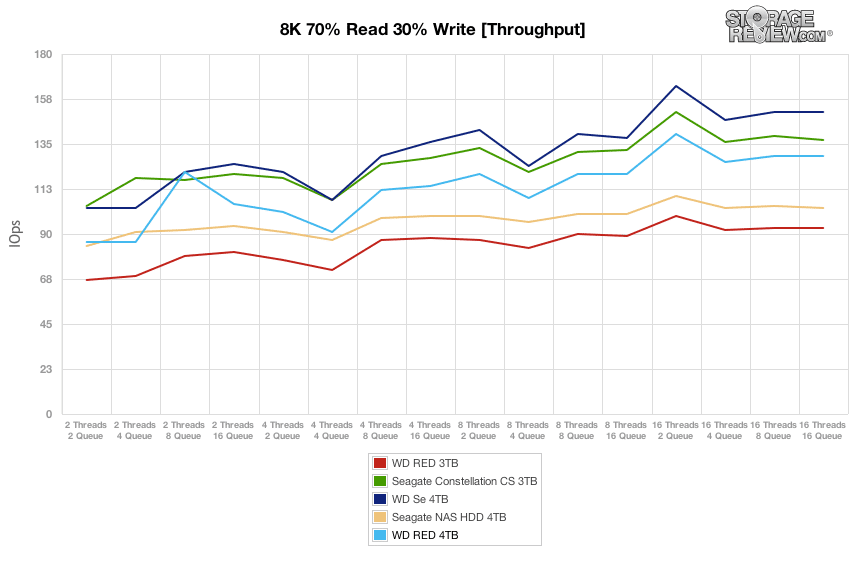
Average latencies for the WD Red 4TB were again in the middle of the pack, but its performance was aligned much more closely with the Seagate’s Constellation CS and the WD Se 4TB than with either the Seagate NAS or the WD Red 3TB.
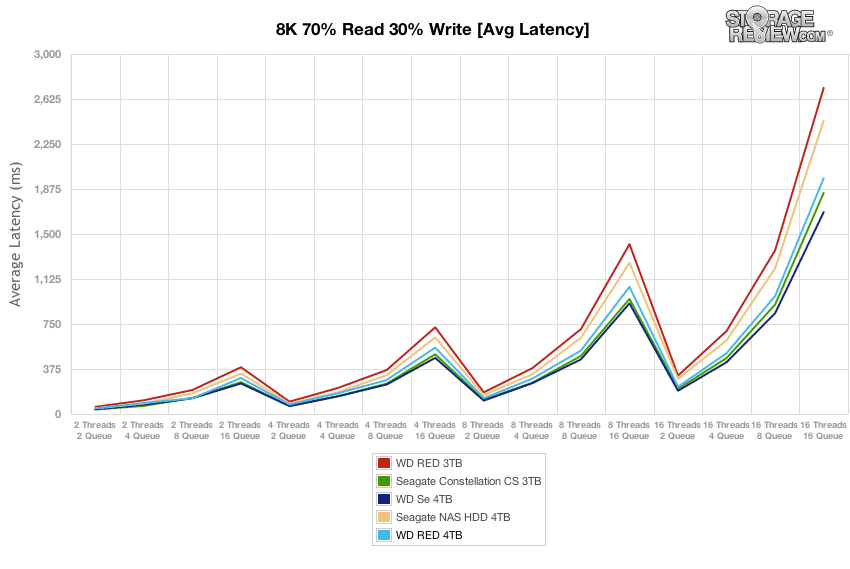
Aside from a jump in maximum latency at a thread count of two and high queue depths, the same points as the WD Red 4TB achieves high throughput, the Red 4TB performs about average throughout the 8K maximum latency benchmark. It’s performance at the greatest workloads is again closer to the Constellation CS 4TB and the Se 4TB than the other comparables.
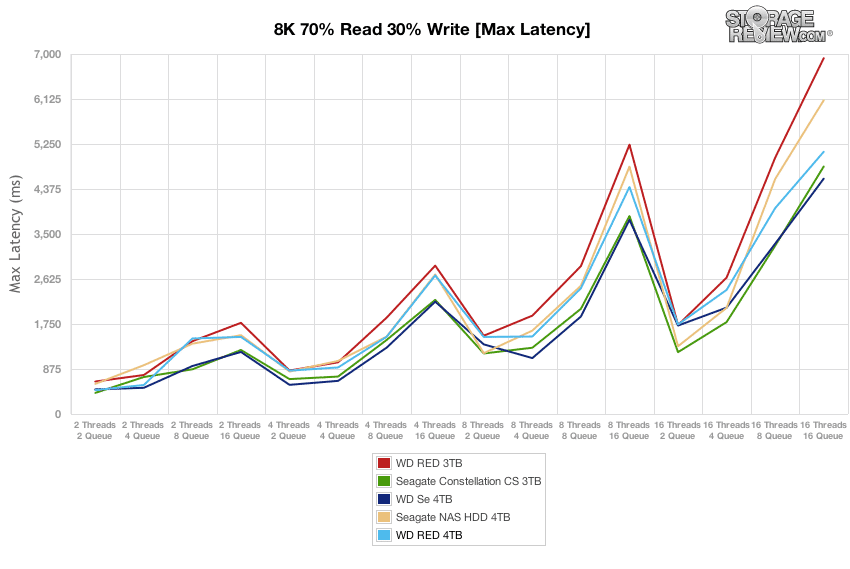
The standard deviation chart illustrates that in terms of the 8k benchmark, the WD Red 4TB’s performance is the middle of the road for the comparables, and consistently superior to both the Seagate NAS 4TB and the WD Red 3TB.
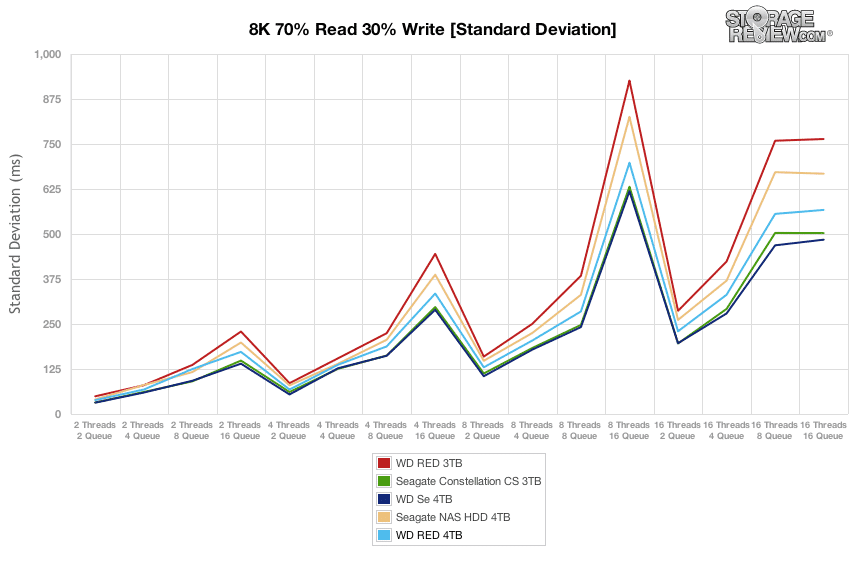
The 128k test is a large block sequential benchmark that shows the highest sequential transfer speed for a platter drive with 100% write and 100% read activity. Here, the Red 4TB performs most similarly to its sibling Red 3TB, coming in with only slightly better sequential throughput in both read and write operations.
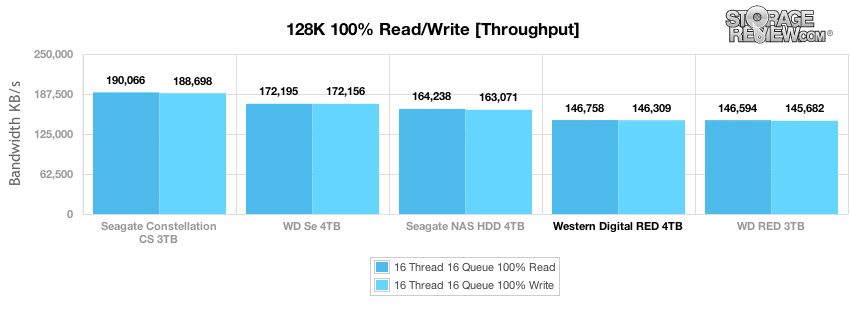
The File Server profile puts the drives through a varying workload with a thread and queue count that scales from 2T/2Q up to 16T/16Q. The WD Red again exhibits strong performance with two threads and a deep queue, but otherwise remains in the median position.
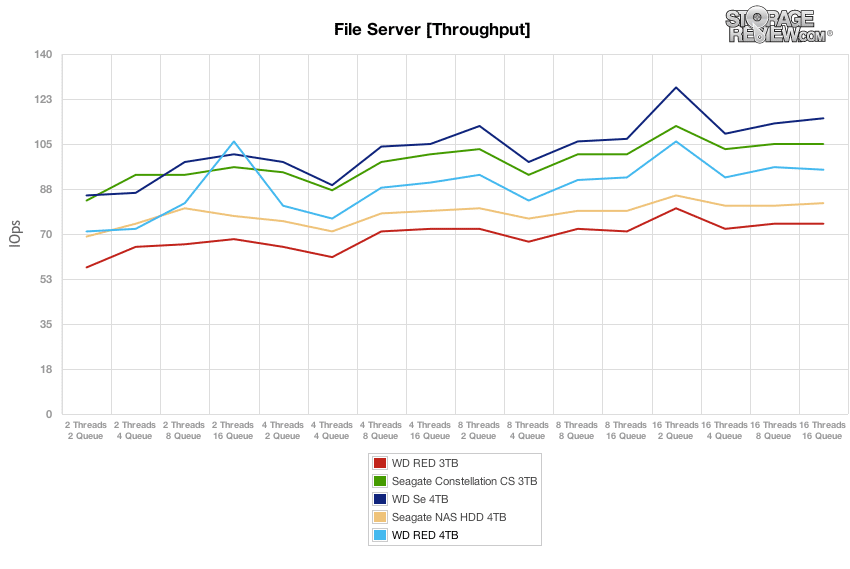
The WD Red 4TB performs well, but not exceptionally in the file server average latency evaluation.
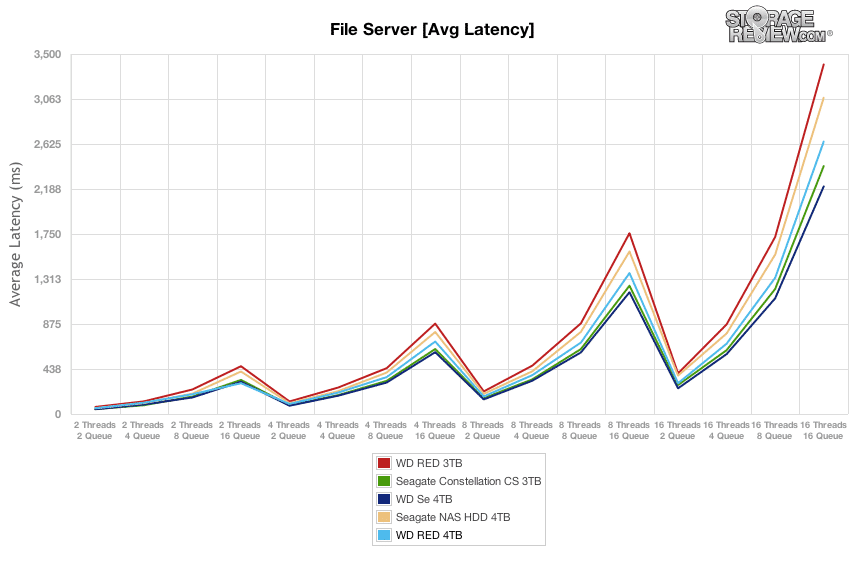
Aside from strong performance in low thread, low queue scenarios, the Red 4TB maintains its middle position throughout the maximum latency benchmark.
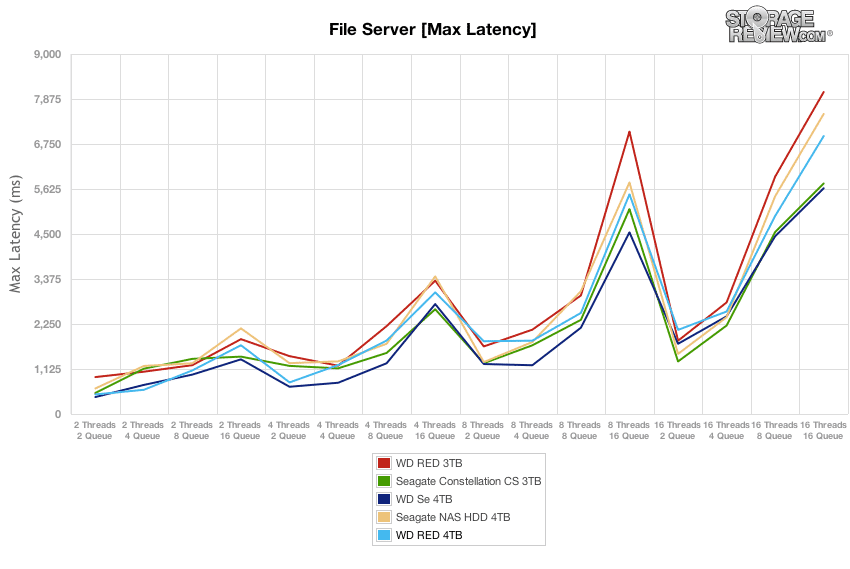
The standard deviation chart further highlights the strong performance at a thread count of two and queue of sixteen. Otherwise, the Red 4TB does not stand out among the comparables but does consistently outperform the Seagate NAS 4TB and the Red 3TB.
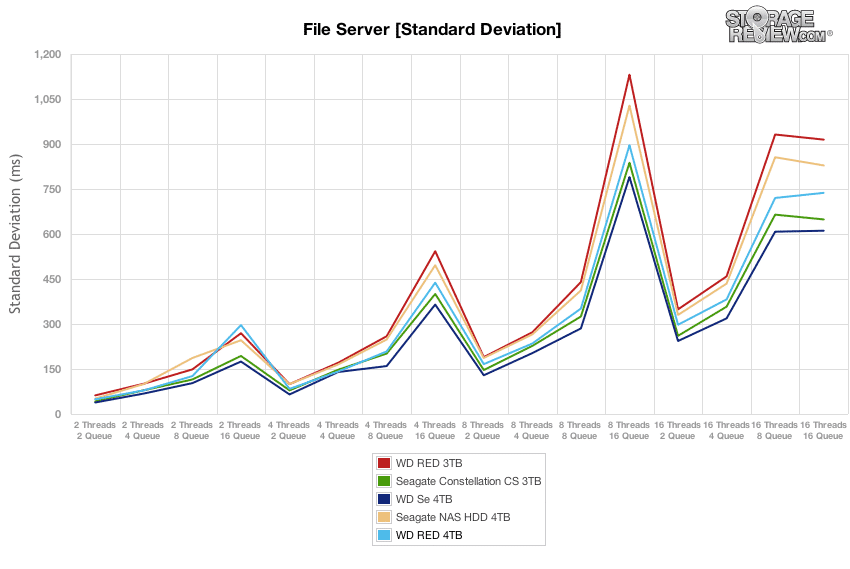
The Web Server test is comprised of 100% read activities across our range of threads and queue depths. As with most of the other benchmarks, the Red 4TB performs better than the Seagate NAS 4TB and WD Red 3TB but not as well as the Constellation CS 3TB or Se 4TB.
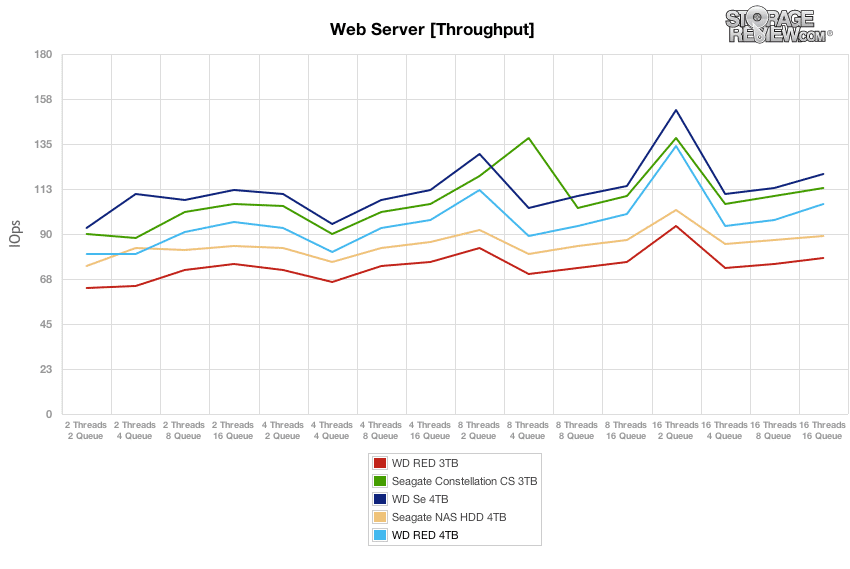
The Red 4TB beats out the other NAS-tuned drives in the web server average latency benchmark as well.
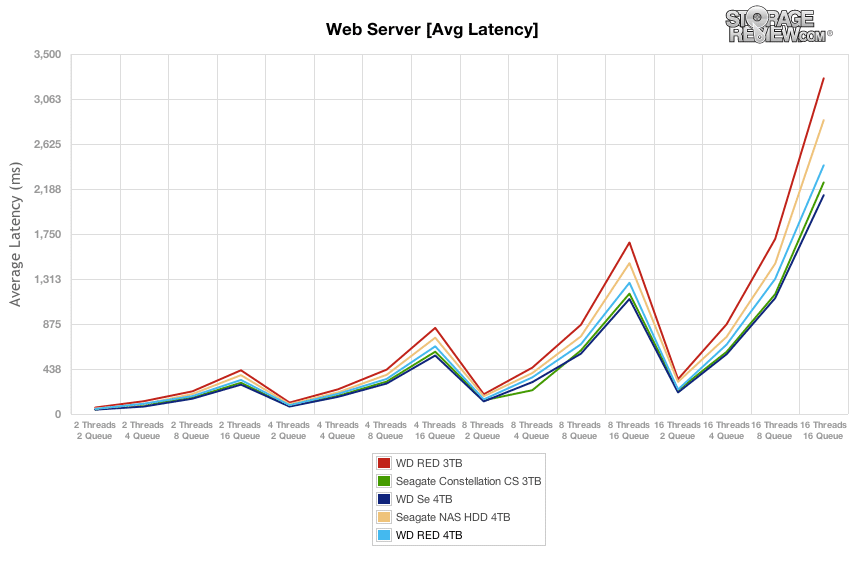
The WD Red 4TB is again weak in the same sections of the two-thread web server maximum latency test where it performs well in terms of throughput, but otherwise puts in a consistent performance throughout this maximum latency profile.
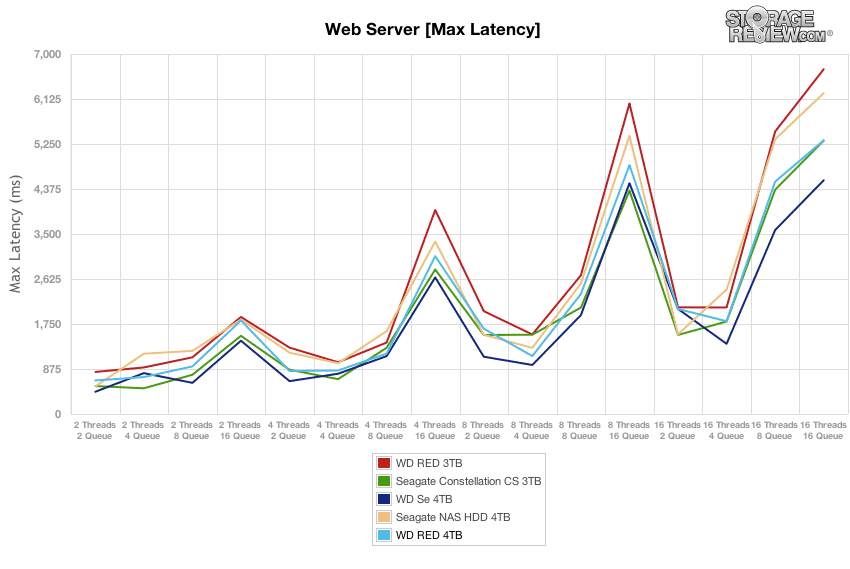
At this point in the benchmarks, we are coming to expect performance better than the Seagate NAS and smaller Red drives, which is what we find with the web server standard deviation benchmark.
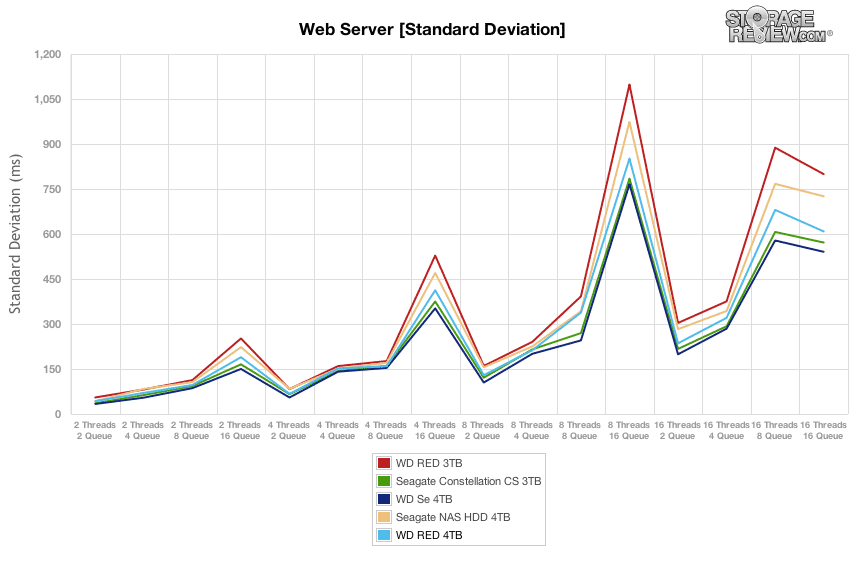
Synology DiskStation DS1513+ Performance
In the second half of this review, we show the performance of both the new 3.5″ WD Red 4TB and the 2.5″ WD Red 1TB HDD. WD supplied StorageReview with 5 samples of both new drives, which we configured in RAID5 in our Synology DiskStation DS1513+. Leveraging SMB/CIFS shares we show how well a 50GB test sample size performed on each storage array we created.
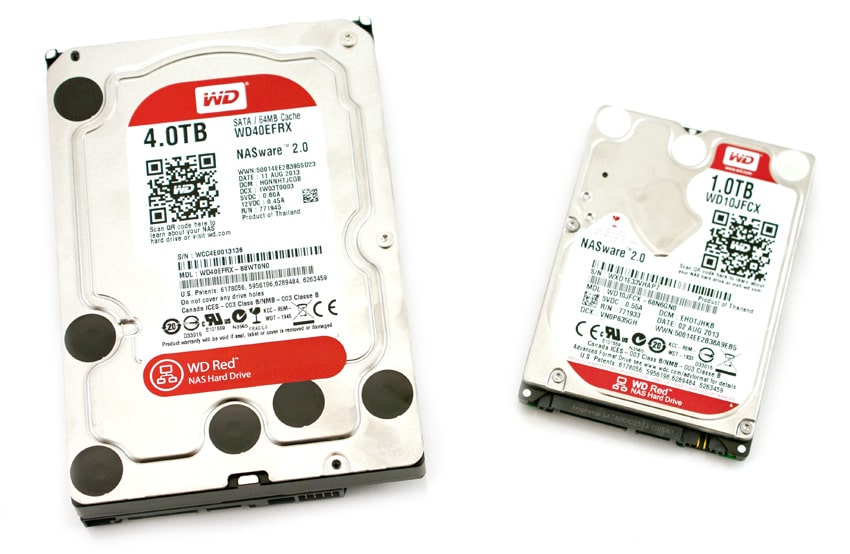
In our first test measuring 4K random performance, the 3.5″ WD Red 4TB and 2.5″ WD Red 1TB both offered a step up in performance compared to the original 3TB WD Red, although still came up slightly behind the Seagate 4TB NAS HDD. The new 1TB WD Red offered storage read performance, although weaker write performance in the group.
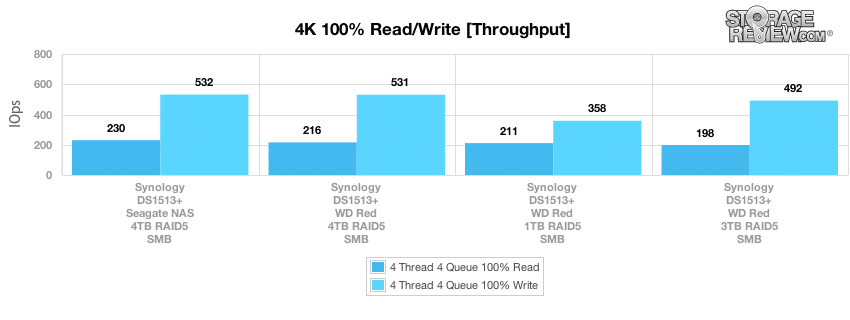
Average latency from the 4TB and 1TB WD Red ranked middle of the pack, showing improvements over the first-generation 3TB WD Red.
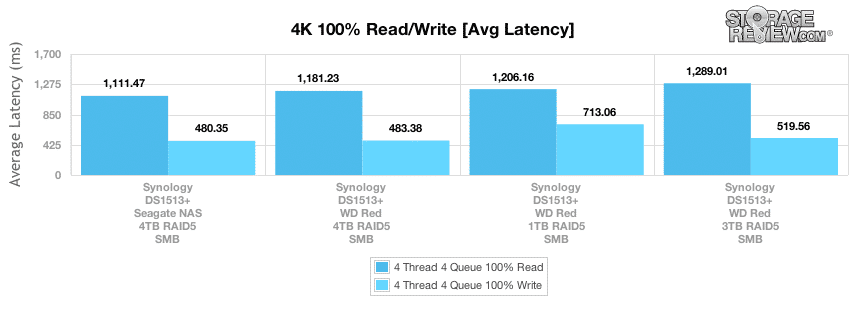
Comparing max latency, the 1TB and 4TB WD Red both came in at the front when it came to peak read latency, although the 2.5″ 1TB Red came in at the bottom of the pack with its higher write latency.
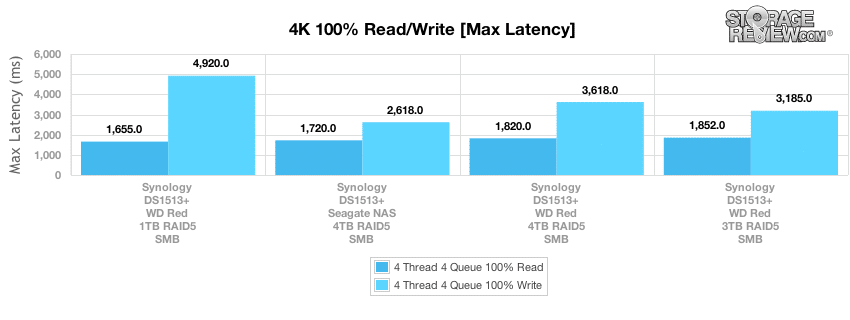
Looking at latency consistency, the 1TB WD Red came in at the top of the pack when it came to read standard deviation, but slipped to the back in respects to its write performance.
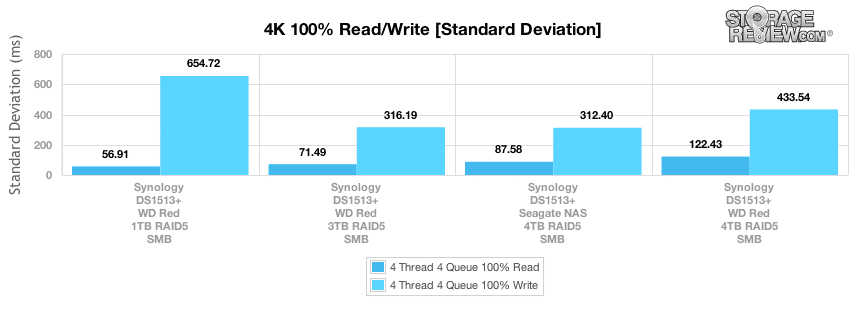
Our next test shifts focus from a pure 4K random read or write scenario to a mixed 8K 70/30 workload. We show how performance scales in this setting from 2T/2Q up to 16T/16Q. When it came down to the drive that offered the best 8K 70/30 throughput, all drives performed very close when configured in RAID5 in our Synology NAS. Comparing first and second generation Red HDDs, the 4TB model did offer some gains over the 3TB version depending on the workload intensity, although those gains did narrow in a few spots. Slotting in between the 3TB and 4TB Red models, the 1TB 2.5″ version proved to be quite capable.
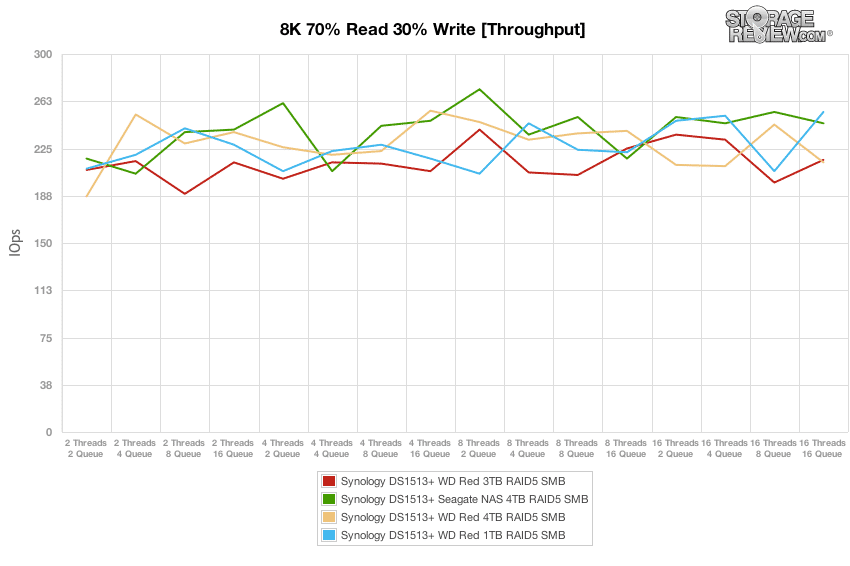
Average latency ranked very close when comparing all the NAS-specific models in our 8K 70/30 test, with the 4TB WD Red and 4TB Seagate NAS both edging towards the front of the group, and the 1TB Red coming in towards the middle.
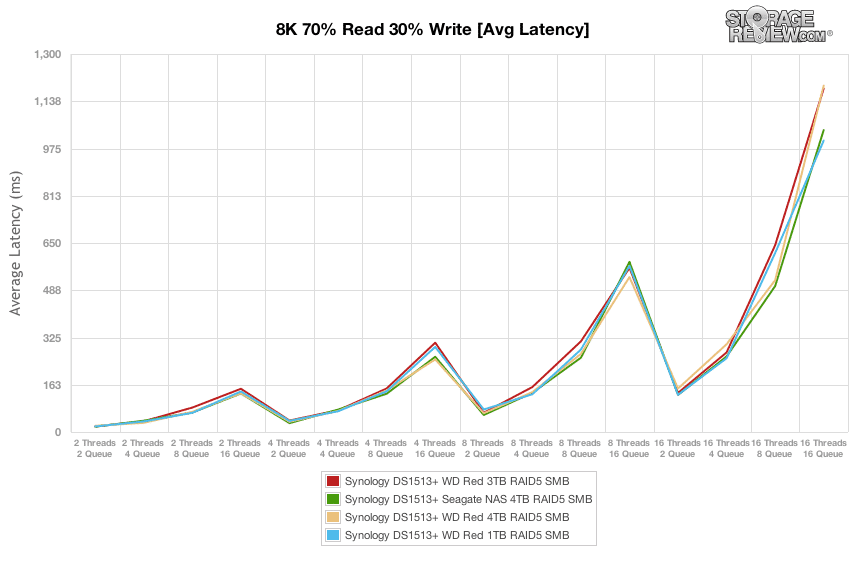
Looking at max latency, there wasn’t really a clear winner in our 8K 70/30 test, with most drives trading positions across our different thread/queue levels.
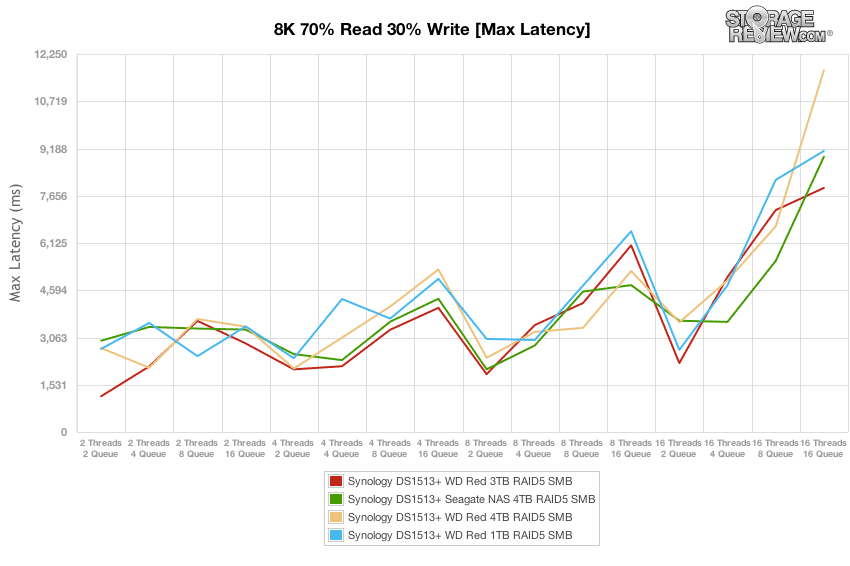
Switching our focus from peak latency to latency consistency in our standard deviation test, the 1TB 2.5″ Red and previous-generation 3TB 3.5″ Red slightly edged out the other models under more stressful conditions.
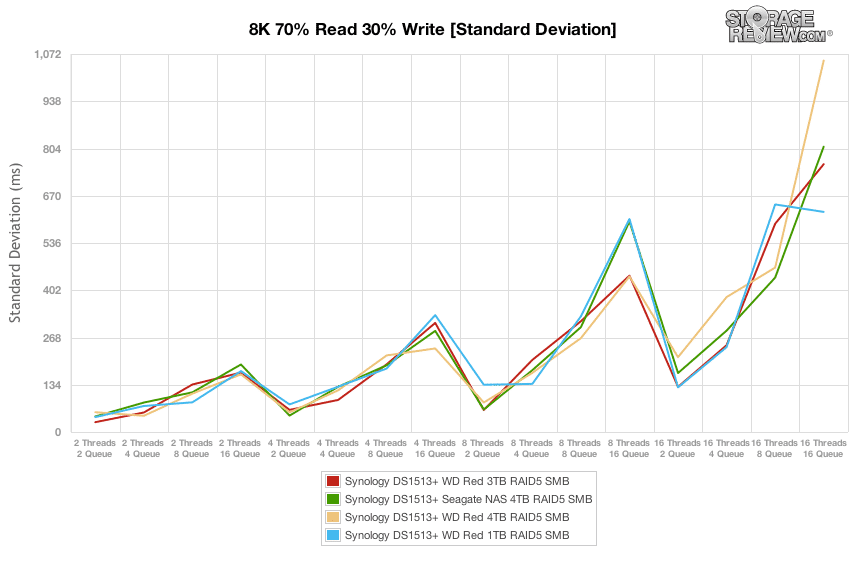
While the first part of the workload comparison measured random workload performance, our second half measures small and large-block sequential transfer speeds. In our first test we measure 8K sequential performance, which we find the 4TB and 1TB WD Red models slipping behind slightly in read performance compared to the 3TB Red, although both offered faster write performance. The leader in this particular test though is the Seagate 4TB NAS that offered both higher read and write throughput.
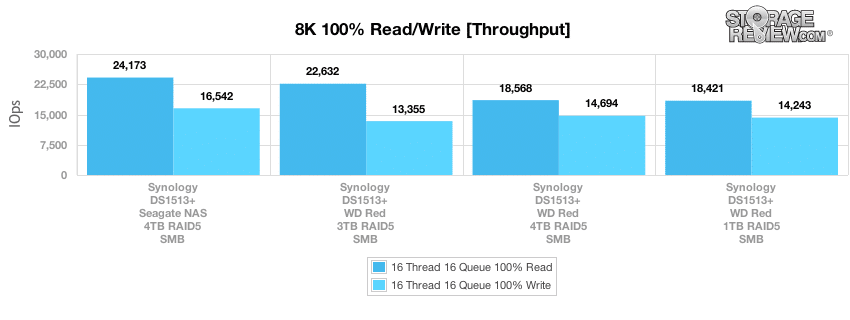
Our last test looks at large-block sequential performance, which both the 1TB and 4TB WD Red lead the group in. The 2.5″ model offered the highest read performance by a slim margin, although when comparing write speed it came in third place. The new 4TB WD Red though came in with the second highest read speed and best-in-class write performance.
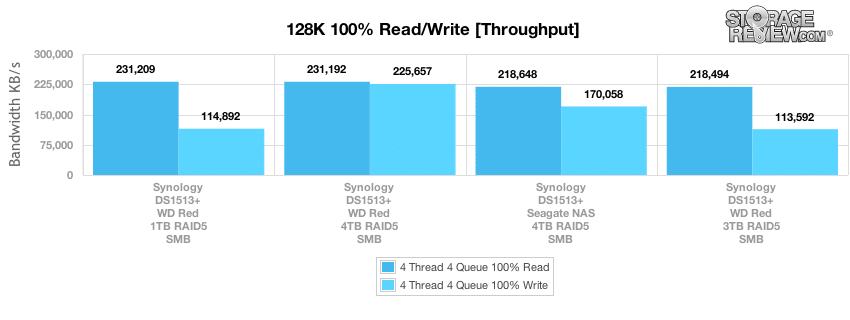
Conclusion
The WD Red HDDs are designed as the simple answer to the question: Which hard drive should I install in my NAS? Based on its consistent performance in our benchmarks, it is a good choice for NAS owners looking to maximize the capacity of their network storage device. The Red 4TB outperforms the Seagate NAS 4TB as well as the WD Red 3TB in our single drive benchmarks, while often managing performance near that of the Seagate Constellation CS or WD Se. When put in a multi-drive environment which these NAS HDD models are designed for, the 4TB Red offered competitive performance in both random and sequential workloads, and shined when it came to offering some of the strongest large-block sequential read and write speeds.
Designed for both consumers and small businesses, the WD Red is a high reliability, low-power consumption device that provides 24×7 operation and now ships in a 4TB capacity that updates the line. Those features are extremely important to users in the market. WD’s NASware 2.0 firmware optimizes the drive to operate in NAS environments by reducing noise and power consumption, providing tools to resolve issues, and limiting vibration. As we were able to show in this review, many of these updates paid off in our NAS environment.
Pros
- At 4TB, this is now the largest hard drive available from WD that is tuned for NAS applications.
- Performs better than the Seagate NAS 4TB and the WD Red 3TB in single-drive benchmarks
- Ranks very well in a multi-drive RAID5 setting in our Synology NAS environment
Cons
- Slipped behind the 4TB Seagate NAS HDD in multi-drive small block sequential transfer speeds
Bottom Line
The WD Red 4TB HDD provides consumers and small businesses with a simple, go-to product when they require a 24×7 solution for their 1 to 5 bay NAS that is both reliable and provides features not found on standard HDDs.
4TB WD Red at Amazon.com



 Amazon
Amazon